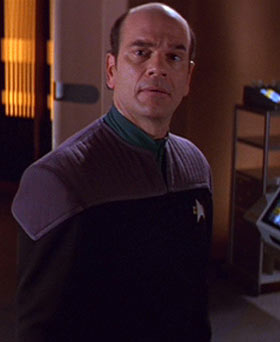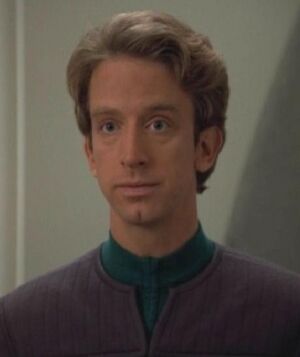Emergency Medical Holographic Program

The Emergency Medical Holographic program (EMH) is a sophisticated hologram developed in the early 2370s by Starfleet and used on most Federation starships in the late 24th century. It was designed to provide short-term advanced assistance during emergencies in sickbay to the extent of literally replacing a starship's medical officer. (DS9: "Doctor Bashir, I Presume") The first starship to be equipped with an EMH was the USS Voyager, although the Equinox, which was commissioned sometime the previous year, also had an EMH program. (VOY: "Relativity", "Equinox") The formal name of the program is EMH Program AK-1 Diagnostic and Surgical Subroutine Omega-323.
There is an apparent contradiction as to which starship was the first to have an EMH. Although it is specifically stated in "Relativity" that Voyager was the first starship to be equipped with an EMH, it was later revealed that the Equinox, which had been launched months prior to Voyager, also had an EMH program. There is no canon explanation for this discrepancy, although it may be that Voyager received their EMH during construction while the one aboard Equinox was installed just prior to that ship's launch.
History[edit]
First activated on stardate 48315, it was developed by Dr. Lewis Zimmerman at the Jupiter Station Holoprogramming Center as the embodiment of modern medicine. The EMH was programmed with 5 million possible treatments from the collective information of 2000 medical references and the experience of 47 individual medical officers. The EMH was also supplemented with contingency programs and adaptive programs to learn while serving as a supplement of a normal medical staff in cases of emergency. It contains 50 million gigaquads of computer memory, which is "considerably more than most highly developed humanoid brains." (VOY: "Lifesigns")
Some biological Starfleet doctors objected to the use of the EMH. Doctor Beverly Crusher swore that she would never use one, although she was forced to do so in order to create a distraction while the Borg tried to assimilate the USS Enterprise-E, allowing her, her medical staff, and her patients, notably Lily Sloane, to escape from sickbay. (Star Trek: First Contact)
The Doctor, a Mark I, originally objected to being the replacement for the entire medical staff of USS Voyager, as the EMH program was only meant to function for a maximum of 1,500 hours (62.5 days); after this time, memory degradation would occur. Fortunately, with the help of his colleagues, his program was altered to overcome this shortcoming. (VOY: "The Swarm") Starfleet would later request a holoprogram designed to operate as a full-time doctor in any posting where life support or living space was at a premium and the primary mission did not require the doctor to leave sickbay. As a result, the research and design for the Long-term Medical Holographic program was begun in mid-2373. (DS9: "Doctor Bashir, I Presume")

As of 2376, there have been four versions of the EMH, called Mark I, II, III and IV. The Mark I's outward appearance was a copy of its inventor, Dr. Zimmerman. However, as the Mark II was released to overcome the defects of the Mark I, the first version soon became obsolete and, thus, was reconfigured for menial tasks such as to scrape plasma conduits or to mine dilithium ore. At least 678 Mark I's were created – 675 reconfigured for menial tasks, one aboard Voyager, one aboard the Equinox, and the backup copy of Voyager's EMH which is in possession of the Kyrians – assuming these were not counted among those reconfigured. (VOY: "Life Line")
Furthermore, the patterns of behavior of the following versions were designed to be more pleasant and courteous and their outward appearance was changed. In addition to that, new ship designs like the USS Prometheus enabled full mobility for the EMH, as the whole ship was outfitted with holographic projectors.
After the EMH Mark II supplanted the "inferior" Mark I, the only remaining versions to fulfill their original programming were aboard the USS Voyager and the USS Equinox, which were both stranded in the Delta Quadrant and had to implement the emergency holograms for extended periods of time. In 2376, the Equinox EMH was deleted while in Voyager's database, leaving Voyager's program, "The Doctor", as the only Mark I still operating as an EMH.
Voyager's EMH (the Doctor) developed a distinct personality over the ship's seven-year-long journey to the Alpha Quadrant. Despite this, "the Doctor" was not granted the rights of a living person by a Federation Arbiter, although he did determine that "the Doctor" fulfilled the requirements of an artist under the law. The Arbiter did, however, encourage "the Doctor" to pursue recognition as a sentient being at a later point in time. (VOY: "Author, Author")
An ability unique to "the Doctor", Voyager's EMH was able to leave sickbay or the holodeck and to roam freely with the help of a mobile emitter (originating from 29th century technology)(VOY: "Future's End, Part II")mem. The Voyager's EMH was even given the responsibility of commanding the ship as the Emergency Command Hologram (ECH) if the ship's commanding officers were not present, incapacitated, or even dead. (VOY: "Tinker Tenor Doctor Spy", "Workforce", "Workforce, Part II", "Renaissance Man")
When the Doctor was sent in a holographic data stream to contact the USS Prometheus, he found the starship in the hands of Romulans, who had killed the Starfleet crew and captured the ship. The Doctor activated the ship's EMH, a Mark II, to help him recapture the ship, although the Mark II initially preferred to just deactivate and wait for rescue, and then treated the Doctor as inferior despite the other's vastly superior experience of life in general. The Doctor ultimately persuaded the Mark II to take action and help him. They planned to disable the Romulans by venting an anesthetic gas, but The Doctor was captured by the Romulans when he attempted to reach the environmental controls on the bridge. During the Doctor's interrogation, the Mark II simulated a bio-hazard, opening the vents which released the gas, knocking out the Romulans. The Doctor and the Mark II successfully fought off Romulan warbirds using the ship's experimental weapons systems, and returned the ship into Starfleet's hands, and informing them that Voyager was in the Delta Quadrant. (VOY: "Message in a Bottle")
Deep Space 9 did not have an EMH installed as it was incompatible with the station's Cardassian technology. An EMH was installed in 2373 as a way to transfer its data into the Long-term Medical Holographic program (LMH). (DS9: "Doctor Bashir, I Presume")
It is unknown if the EMH was kept aboard the space station.
By 2376, the Mark II had been replaced by a Mark III, followed by a Mark IV. (VOY: "Life Line")
Neither the Mark III or Mark IV programs were shown on-screen, nor was it revealed what happened to the Mark II.
Mechanics[edit]
- The EMH is a holographic simulation of a Human, but with no internal organs beneath the apparent surface to conserve computer power. EMHs are not equipped with reproductive organs. The Doctor, however, wrote additional routines into his holomatrix to facilitate romantic endeavors and has also had several relationships, one of which resulted in a son. (VOY: "Message in a Bottle", "Blink of an Eye")
- Holodecks use omnidirectional holographic diodes. A sickbay is fitted with a system of OHDs that project an image of the EMH. Each projects a complete image. Visible portions change as the hologram moves, creating an illusion of fluid motion.
- Magnetic containment fields allow the EMH to interact with physical objects. These force fields move as the EMH moves to create the appearance of solid matter. The containment fields can be shut off, allowing objects and people to pass through them – an EMH's cohesion can range from solid to intangible. (VOY: "Phage")
- When OHDs and magnetic field generators are added to other parts of a ship, they allow the hologram to leave sickbay (as in more advanced Starfleet ships).
- The universal translator algorithm is written into the EMH's matrix. (VOY: "Gravity")